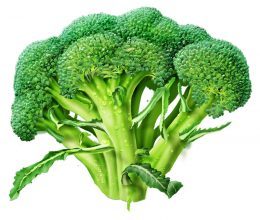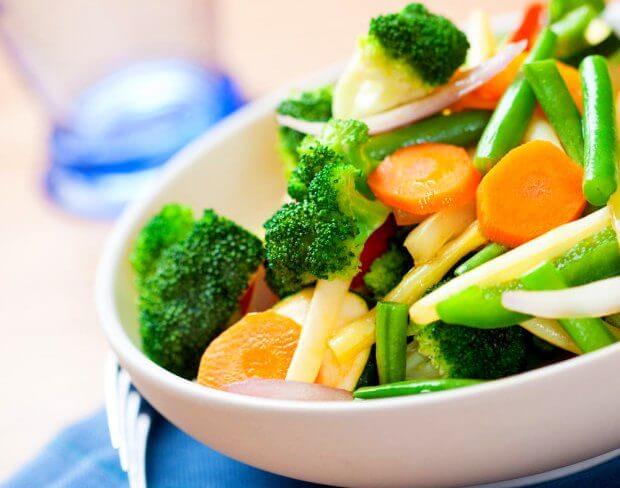There is a lot of talk about benefits of raw foods these days, and rightly so. However, let’s not forget that a number of cooked foods, especially vegetables, are also very nutritious and good for us and, in many cases, trump the raw varieties in health benefits. Cooked vs raw vegetables – let’s consider three popular ones: tomatoes, broccoli and carrots.
Tomatoes

High in water, vitamins (C, A and K), minerals (potassium, manganese, iron) and antioxidants such as lycopene (see information below), tomatoes are a great food choice and people of all ages and cultures like and eat them regularly. However, preparation methods do matter when it comes to extracting the many health benefits.
Cooked
- Processed tomatoes (cooked into a paste, sauce or stewed) as well as canned varieties are the richest known sources of lycopene. Lycopene is a powerful antioxidant (a compound that blocks the action of free radicals that can damage cells causing ageing, cell and organ damage leading to most illnesses) scientifically proven to prevent and treat many cancers including prostate, lung, stomach, bladder, cervix and skin, among others. Deep red tomatoes have more lycopene and overall antioxidant activity than yellow, gold or green tomatoes.
- Tomato paste is the most concentrated form of processed tomatoes and has up to 10 times more lycopene than raw tomatoes (verified by studies).
- The heat applied during the processing makes the lycopene changes its structure and become more available for the body to absorb and utilise.
- Quite often cooked tomatoes have much more flavour than typical supermarket ones which are usually picked unripe and then stored losing much of the flavour and nutritional value in the process.
- Tomatoes used by the food industry for canning are picked when red-ripe and they are usually processed within a short period of time. Therefore their flavour and nutrients are largely preserved.
- Be mindful that most processed tomatoes are sold in cans that have plastic lining that contains a toxic chemical called BPA (bisphenol A). High acidity, a well-known characteristic of tomatoes, causes BPA to leach into the pulp. BPA has been linked to reproductive abnormalities, neurological effects, heightened risk of breast and prostate cancers, diabetes, heart disease and many more. To avoid this nasty chemical, switch over to brands that use BPA-free containers (check the label) or even better, glass containers.
- Tomatoes produce lycopene to protect themselves from the sun’s UV rays. Eating cooked tomatoes has the same protective effect on our skin – lycopene acts like a natural sunscreen but from within!
- Importantly, always choose products made of organically grown tomatoes (both fresh or cooked) to avoid pesticides and other chemicals. Look for organic varieties sold in supermarkets and farmers markets.
Raw
- Store fresh tomatoes at room temperature to preserve their flavour.
- Use the skin and seeds, they are the most nutritious part of a tomato.
- As a rule, the smaller the tomato the higher its sugar and lycopene content.
- Lycopene is fat soluble meaning it needs fat/ oil to be absorbed and utilised by the body, so when eating raw tomatoes drizzle them with some good fat such as olive oil or coconut oil.
Conclusion – cooked tomatoes have more health benefits and a better taste and are recommended to have on a regular basis. Raw tomatoes, which are richer in vitamin C, are good for you too – grow your own for a better flavour and freshness!
Broccoli

Broccoli is high in
fibre, vitamins and minerals and phytonutrients essential for good health. It’s best eaten within a week of harvesting as it rapidly loses nutrients after picking. This also applies when broccoli is stored, even under ideal conditions. In order to preserve all the nutrients in broccoli, it must be chilled as soon as it’s harvested, kept cool and eaten within two or three days. This is hard to achieve given the current system of transportation and storage. Still, most broccoli sold at farmers markets is fresh and highly nutritious – look for a vendor who has the broccoli on ice or in a cooler.
Cooked
- Cooked broccoli is easier to eat and digest as the tough fibres are softened and partially broken down during cooking. Best way to cook broccoli is to steam it for no more than 4-5 minutes. Steaming softens the cell structure but retains the most nutrients and also prevents the formation of unpleasant odours and flavours. One study found that steaming green vegetables greatly improved their ability to bind to bile acids, which improves their cholesterol-lowering abilities.
- According to the Weston Price Foundation, steaming broccoli until fully cooked reduces the goitrogens (see the Raw section below) to one-third the original value on average. Since release of the goitrogens from steamed broccoli depends on intestinal bacteria, the amount released varies from person to person. Boiling for 30 minutes reliably destroys 90% of the goitrogens.
- Another beneficial way to cook broccoli is to sauté or stir-fry them in butter or coconut oil with a piece of garlic and/ or slices onion. That way it doesn’t lose any of their water-soluble nutrients, including vitamin C and folate.
Raw
- Eating broccoli raw will give you up to 30 times more of the anti-cancer compound called sulforaphane than cooked broccoli. Have it in salads and with dips. It’s important to chew it really well to release the nutrients and improve its digestion and assimilation (gut bacteria feast on it producing beneficial compounds).
- However, high intake (4-6) times per week) by people with underactive thyroids can lead to worsening of those conditions as the compounds called goitrogens present in broccoli inhibit the uptake of iodine by the thyroid gland. Therefore it’s important for people with underactive thyroids limit raw broccoli and eat cooked instead. This effect can be lessened by an increased dietary intake of iodine from seaweed, fish and seafood.
- On the other hand people with overactive thyroid conditions such as Graves’ disease should eat more broccoli and other cruciferous vegetables (cabbage, cauliflower, kale, bok choy) to block the absorption of the iodine and thus support any medications and/ or natural medicines.
- Frozen broccoli is convenient but less nutritious than fresh broccoli. It’s a standard manufacturing practice to steam or boil the vegetable for a few minutes to deactivate the enzymes which would degrade the flavour and quality during storage. These procedures destroy a large amount of nutrients.
Conclusion – chose raw or cooked broccoli according to your digestive efficiency and be mindful of any health conditions you may have that make you sensitive to the effects of goitrogens on the thyroid gland.
Carrots

Needless to say, carrots are one of the most popular vegetables on our tables. They are high in fibre, low in calories and are a good source of an important antioxidant beta-carotene. They have many health benefits including improving cardiovascular health, vision and also have impressive anti-cancer properties. How we prepare and eat them makes a big difference though.
Cooked
- Cooked carrots are actually more nutritious than raw ones as the heat makes the nutrients, especially beta-carotene, more bioavailable so we get more out of what we eat.
- It also matters how you cook carrots. Importantly, if you cook carrots whole and then slice them after they’ve been cooked, you get more nutrients than if you cut them before cooking. Boiling causes many of their water soluble nutrients to leach into the cooking water – it’s better to make dishes that contain the water as well. Sautéed or steamed carrots retain more of their food value because the carrots are in contact with less water.
- Importantly, carrots are best for you when eaten with some type of oil or fat such as butter, olive oil or coconut oil. Beta-carotene is a fat-soluble nutrient that needs to be coated in fat for better digestion and absorption.
Raw
- Carrots contain nutrients called carotenes which are not true vitamin A but are more accurately termed provitamin A. True vitamin A, or retinol, is found only in animal products like cod liver oil, liver, fish, shell fish and butter from cows eating green grass.
- Under optimal conditions, we convert carotenes to vitamin A in the small intestine; however, this is rarely optimal. Diabetics and those with poor thyroid function have great difficulties making the conversion. A low fat diet, strenuous physical exercise, excessive consumption of alcohol, excessive consumption of iron (especially from “fortified” white flour and breakfast cereal), a number of drugs, excessive consumption of polyunsaturated fatty acids, zinc deficiency and even cold weather can hinder the conversion of carotenes to vitamin A.
- Chewing well is important – carrots need to be thoroughly chewed to soften the hard cells and release the nutrients and fibre in the intestines. The under skin portions of carrots are rich in phytonutrients so eating carrots with the skin is more beneficial. Cut them into sticks and serve with dips for a great snack.
- For the freshest and sweetest flavour buy carrots with their green tops still attached but cut off the tops before refrigerating to preserve the moisture inside.
- For most benefits choose mature carrots over so-called baby carrots sold in plastic bags. These are most likely misshapen mature carrots that have been cut down to a smaller and more uniform size losing their under skin nutrients on the way.
- Remember to add some good fats like extra virgin olive oil to you freshly squeezed carrot juice!
Conclusion – cooked carrots eaten with added fat are better especially for those with impaired digestion as well as for stressed out people with low in energy and fatigue. Of course a balanced diet should also include raw carrots, in moderation as discussed above. Also, remember that the
vegetables are best and most nutritious when eaten in season. Good health and blessings
 Joanna Sochan
Joanna Sochan Holistic Health and Lifestyle Therapist Natural and Lifestyle Therapies for Abundant Health and Wellbeing References
Photo credit: Shutterstock Check out other posts:
 Joanna Sochan
Joanna Sochan is a Natural Therapist and founder of Naturimedica Holistic Health & Wellness. She has a passion for helping her clients transform their lives by becoming healthy and well naturally. Joanna is a fatigue, sleep and gut health expert helping tired, stressed or unwell individuals to regain their energy, sleep better and be happier, more relaxed and calm. Joanna practices in Sydney and Lake Macquarie, Australia and also conducts
online consultations for clients Australia-wide.
View full bio.
 Print This Post
Print This Post  High in water, vitamins (C, A and K), minerals (potassium, manganese, iron) and antioxidants such as lycopene (see information below), tomatoes are a great food choice and people of all ages and cultures like and eat them regularly. However, preparation methods do matter when it comes to extracting the many health benefits.
High in water, vitamins (C, A and K), minerals (potassium, manganese, iron) and antioxidants such as lycopene (see information below), tomatoes are a great food choice and people of all ages and cultures like and eat them regularly. However, preparation methods do matter when it comes to extracting the many health benefits.  Broccoli is high in fibre, vitamins and minerals and phytonutrients essential for good health. It’s best eaten within a week of harvesting as it rapidly loses nutrients after picking. This also applies when broccoli is stored, even under ideal conditions. In order to preserve all the nutrients in broccoli, it must be chilled as soon as it’s harvested, kept cool and eaten within two or three days. This is hard to achieve given the current system of transportation and storage. Still, most broccoli sold at farmers markets is fresh and highly nutritious – look for a vendor who has the broccoli on ice or in a cooler.
Broccoli is high in fibre, vitamins and minerals and phytonutrients essential for good health. It’s best eaten within a week of harvesting as it rapidly loses nutrients after picking. This also applies when broccoli is stored, even under ideal conditions. In order to preserve all the nutrients in broccoli, it must be chilled as soon as it’s harvested, kept cool and eaten within two or three days. This is hard to achieve given the current system of transportation and storage. Still, most broccoli sold at farmers markets is fresh and highly nutritious – look for a vendor who has the broccoli on ice or in a cooler.  Needless to say, carrots are one of the most popular vegetables on our tables. They are high in fibre, low in calories and are a good source of an important antioxidant beta-carotene. They have many health benefits including improving cardiovascular health, vision and also have impressive anti-cancer properties. How we prepare and eat them makes a big difference though.
Needless to say, carrots are one of the most popular vegetables on our tables. They are high in fibre, low in calories and are a good source of an important antioxidant beta-carotene. They have many health benefits including improving cardiovascular health, vision and also have impressive anti-cancer properties. How we prepare and eat them makes a big difference though.  Joanna Sochan is a Natural Therapist and founder of Naturimedica Holistic Health & Wellness. She has a passion for helping her clients transform their lives by becoming healthy and well naturally. Joanna is a fatigue, sleep and gut health expert helping tired, stressed or unwell individuals to regain their energy, sleep better and be happier, more relaxed and calm. Joanna practices in Sydney and Lake Macquarie, Australia and also conducts online consultations for clients Australia-wide. View full bio.
Joanna Sochan is a Natural Therapist and founder of Naturimedica Holistic Health & Wellness. She has a passion for helping her clients transform their lives by becoming healthy and well naturally. Joanna is a fatigue, sleep and gut health expert helping tired, stressed or unwell individuals to regain their energy, sleep better and be happier, more relaxed and calm. Joanna practices in Sydney and Lake Macquarie, Australia and also conducts online consultations for clients Australia-wide. View full bio.  Print This Post
Print This Post 

Leave A Comment